Shokunin Baking and Roasting Set Up
Charcoal roasting and baking adds a unique element of flavor to foods that are not typically kissed with smoke. Smoke roasting, if you haven’t tried it, is next level. Learn how to set up your grill and achieve amazing results for baking and roasting in the Shokunin Kamado.

One of the many benefits of the Shokunin Kamado grill is its ability to hold incredibly stable temperatures for long periods of time. In fact, the Shokunin is more stable than a typical indoor oven, making it superior for both baking and roasting. There are numerous other benefits for roasting or baking with the Shokunin as well.
For example, you don’t have to heat your house up in the summer months by cranking up your oven. During cold weather holidays, you can reserve your oven real estate for side dishes and roast your turkey or prime rib in the Shokunin. Most importantly, charcoal roasting and baking adds a unique element of flavor to foods that are not typically kissed with smoke. Smoke roasting, if you haven’t tried it, is next level.
Recommended Tools
Similar to the set up for low and slow cooking, there’s only minimal equipment needed to get started.
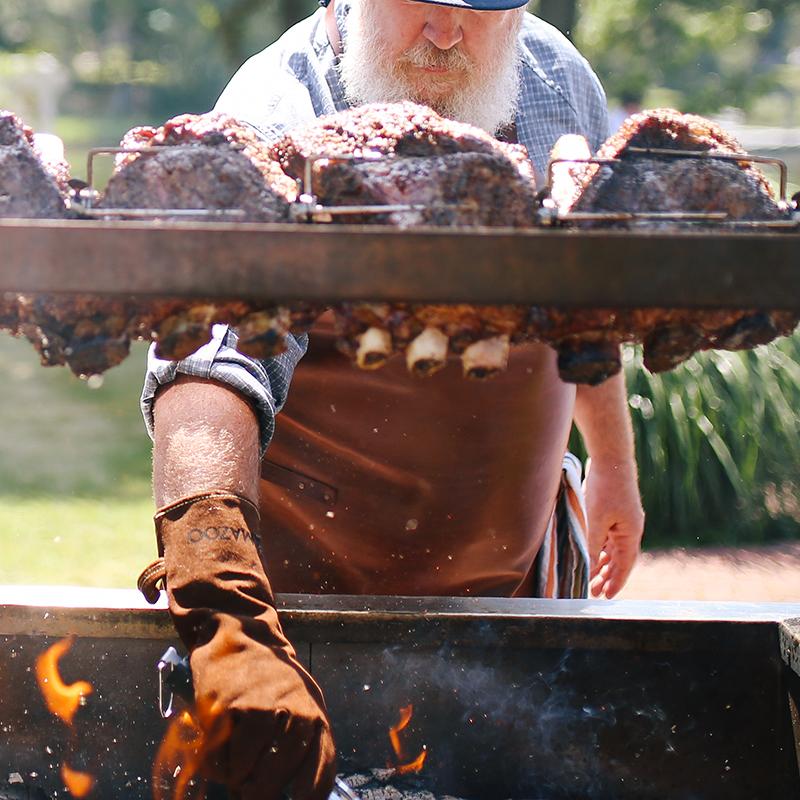
Premium Suede Grilling Gloves
These are for your safety and I highly recommend you wear them when dumping the hot coals from your charcoal fire starter into your Shokunin grill.

Charcoal Chimney
This inexpensive charcoal starter is something you can use every time you *light your Shokunin grill. It’s also a means of measurement for many recipes as you’ll often hear reference to “1/2 a chimney” or “a full chimney” of quality lump charcoal for grill set up.
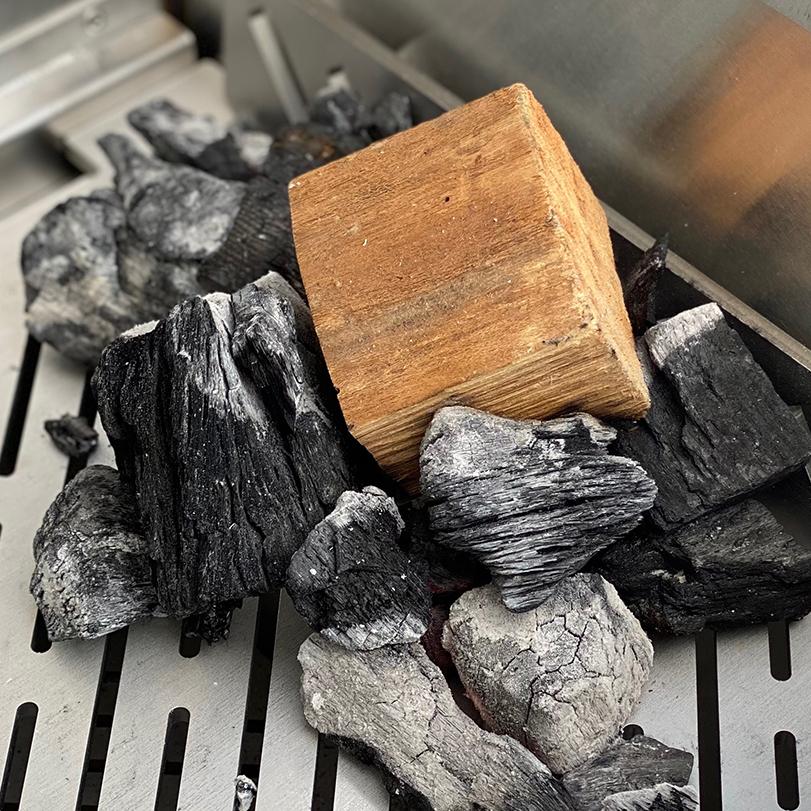
Wood Chunks
Roasting and baking, styles of cooking typically done in the indoor oven, aren’t generally associated with smoke flavor like brisket or pork shoulder. That said, I encourage you to think outside the box and consider the use of wood for roasting.
*A plumber's torch can also be used to light your Shokunin grill following the methods outlined below. When using a plumber's torch, simply position unlit charcoal as desired, and light it with the plumber's torch.
Setting up the Grill
There are two ways to set your grill up for roasting and baking. Choose which makes the most sense based on what you’re cooking.
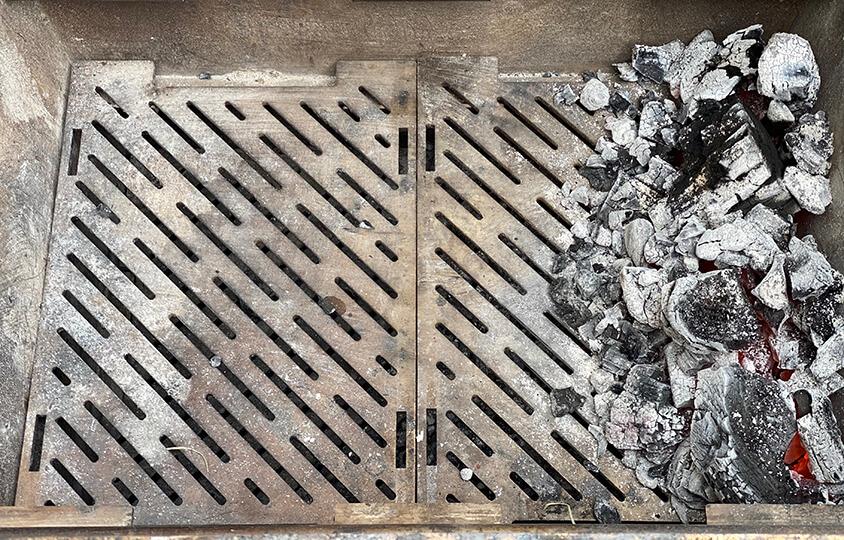
Option 1: Cross Flow
This setup is preferred for roasting poultry, beef, fish and lamb. Positioning the food on the cooking grate opposite the coal placement allows indirect heat (and smoke if you’re smoke roasting) to travel across the food as it exits the grill through the exhaust vent above the food. The cross flow method provides excellent flavor and browning; however, because temperatures at cooking grate level will be higher closer to the fire side of the grill, food may need to be rotated during the cook. When roasting a whole chicken, fish, etc., rotating is easy and only takes seconds.
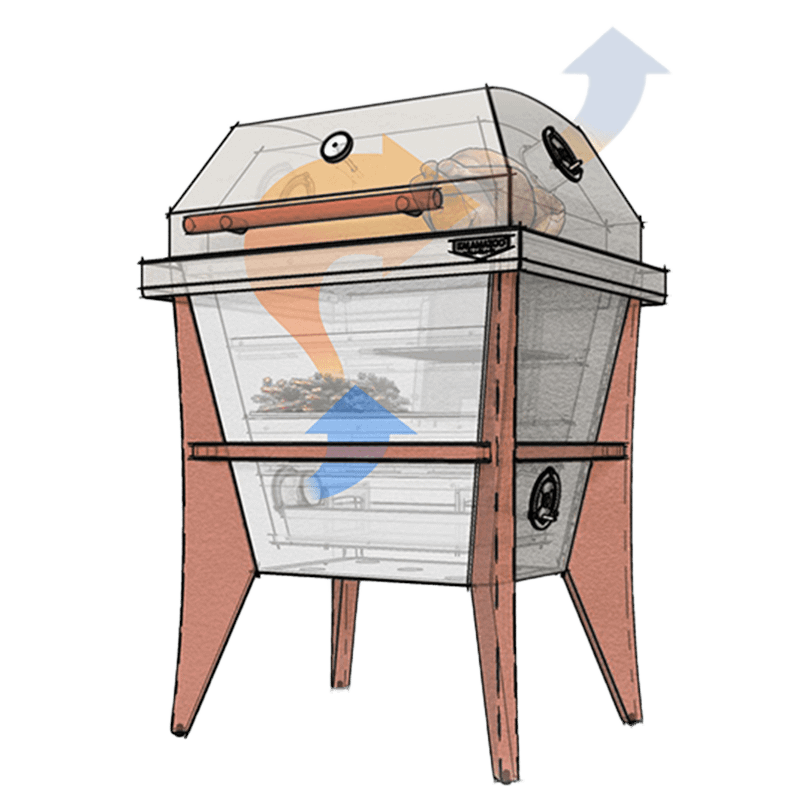
 100% open Position the two bottom supply vents on the grill body and the two top exhaust vents on the grill lid to 100% open. Open the cooking grates and place the adjustable fire grates at the roasting / baking position. This is the middle position just above the main fire grate, and below the grilling position. Place one full chimney of lump charcoal on the adjustable grates and light it using a tumbleweed fire starter or a paraffin cube. Once charcoal has ashed over, using heat-resistant gloves, pour charcoal along either the right or left side of the adjustable fire grate.
100% open Position the two bottom supply vents on the grill body and the two top exhaust vents on the grill lid to 100% open. Open the cooking grates and place the adjustable fire grates at the roasting / baking position. This is the middle position just above the main fire grate, and below the grilling position. Place one full chimney of lump charcoal on the adjustable grates and light it using a tumbleweed fire starter or a paraffin cube. Once charcoal has ashed over, using heat-resistant gloves, pour charcoal along either the right or left side of the adjustable fire grate.
Return the cooking grates to the closed position, and close the grill's lid. Monitor the Shokunin temperature and adjust the vents when the temperature gets to approximately 85% of the desired cooking temperature. For baking this is usually around 350°F and for roasting the temperature is generally about 400°F. Those temperatures may change slightly depending on the recipe, and only require slight adjustments to the exhaust vent(s) to achieve.
For 350° Baking
Once the temperature reaches 85% of the desired temperature, adjust the vents as follows:
Supply Vents
Wearing heat-resistant gloves, adjust the supply vent on the opposite side of the coals to 100% closed. Adjust the supply vent on the coals side to the 30% open position.
 100% closed
100% closed  30% open
30% open
Exhaust Vents
Wearing heat-resistant gloves, adjust the exhaust vent on the side of the grill where coals were placed to 100% closed. Adjust the opposite exhaust vent to 25% open position.
 100% closed
100% closed  25% open
25% open
FOR 400° Roasting
Once the temperature reaches 85% of the desired temperature, adjust the vents as follows:
SUPPLY VENTS
Wearing heat-resistant gloves, adjust the supply vent on the opposite side of the coals to 100% closed. Adjust the supply vent on the coals side to the 35% open position.
 100% closed
100% closed 35% open
35% open
EXHAUST VENTS
Wearing heat-resistant gloves, adjust the exhaust vent on the side of the grill where coals were placed to 100% closed. Adjust the opposite exhaust vent to 25% open position.
 100% closed
100% closed  25% open
25% open
Depending on a few factors, slight adjustments to the exhaust vents may need to be made to achieve desired temperatures. These settings should get your grill in close proximity to typical roasting and baking temperatures.
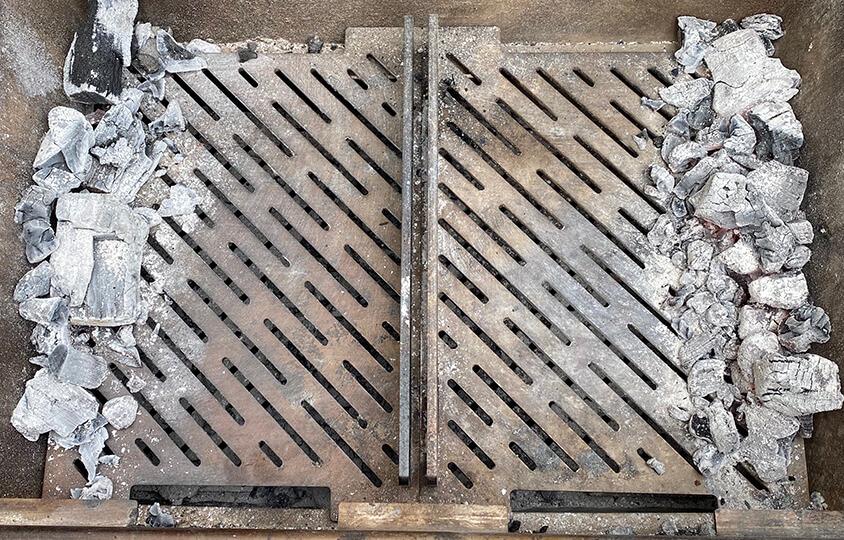
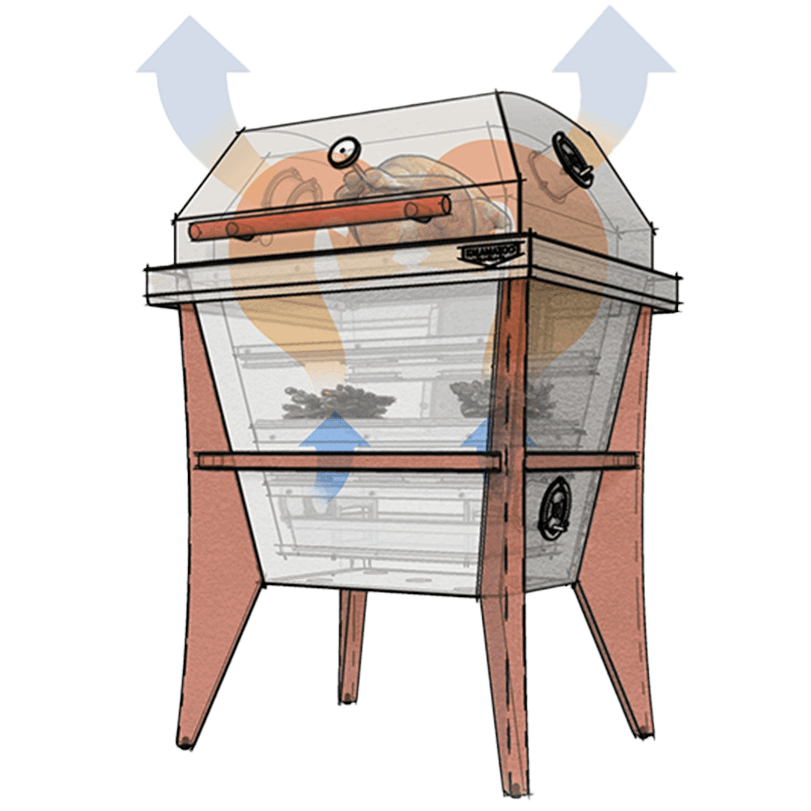
Option 2: Envelop
This setup is preferred when rotating food during the cook isn’t practical. Smaller foods, or foods that don’t have an internal structure that benefit from, and sometimes require the use of a baking sheet or other cooking vessel to transport to and from the grill. Foods like roasted sweet potatoes or baked corn bread, for example. With this set up, food is positioned center on the cooking grate. This allows indirect heat (and smoke if you’re smoke roasting) to envelop the food as it exits the grill through both exhaust vents. The envelop setup still provides excellent flavor and browning and doesn’t require the food to be rotated during the cook as heat is evenly distributed on both sides. Smoke or charcoal flavor however, will be slightly less present using this method.
 100% open Position the two bottom supply vents on the grill body and the two top exhaust vents on the grill lid to 100% open. Open the cooking grates and place the adjustable fire grates at the roasting / baking position. This is the middle position just above the main fire grate, and below the grilling position. Place one full chimney of lump charcoal on the adjustable grates and light it using a tumbleweed fire starter or a paraffin cube. Once the charcoal has ashed over, don a pair of heat-resistant leather gloves and evenly distribute the charcoal by pouring it along the right and left side of the adjustable fire grates.
100% open Position the two bottom supply vents on the grill body and the two top exhaust vents on the grill lid to 100% open. Open the cooking grates and place the adjustable fire grates at the roasting / baking position. This is the middle position just above the main fire grate, and below the grilling position. Place one full chimney of lump charcoal on the adjustable grates and light it using a tumbleweed fire starter or a paraffin cube. Once the charcoal has ashed over, don a pair of heat-resistant leather gloves and evenly distribute the charcoal by pouring it along the right and left side of the adjustable fire grates.
Return the cooking grates to the closed position, and close the grill's lid. Monitor the Shokunin temperature and adjust the vents when the temperature gets to approximately 85% of the desired cooking temperature. For baking, this is usually around 350°F and for roasting the temperature is generally about 400°F. Those temperatures may change slightly depending on the recipe, and only require slight adjustments to the exhaust vent(s) to achieve.
FOR 350° baking
Once the temperature reaches 85% of the desired temperature, adjust the vents as follows:
SUPPLY VENTS
Wearing heat-resistant gloves, adjust both supply vents to 25% open.
 25% open
25% open  25% open
25% open
EXHAUST VENTS
Wearing heat-resistant gloves, adjust both exhaust vents to approximately 20% open.
 20% open
20% open 20% open
20% open
FOR 400° Roasting
Once the temperature reaches 85% of the desired temperature, adjust the vents as follows:
SUPPLY VENTS
Wearing heat-resistant gloves, adjust both supply vents to 20% open.
 20% open
20% open  20% open
20% open
EXHAUST VENTS
Wearing heat-resistant gloves, adjust both exhaust vents to approximately 15% open.
 15% open
15% open  15% open
15% open
Depending on a few factors, slight adjustments to the exhaust vents may need to be made to achieve desired temperatures. These settings should get your grill in close proximity to typical roasting and baking temperatures.

